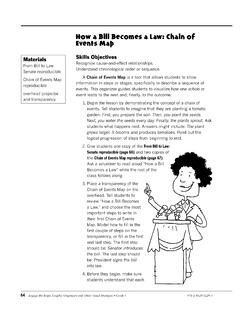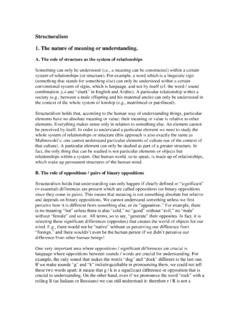Transcription of Stuart Hall and Cultural Studies: Decoding Cultural Oppression
1 Stuart Hall and Cultural Studies: Decoding Cultural Oppression Represent! In American pop culture to represent means to carry the name of a certain area or group. For example, people can represent their neighborhood, sports team, or music group by shouting out, or wearing the right colors, tee-shirts, stickers, and so on. To represent means to faithfully carry the identity of an area or group, to do it honor and to make others aware. To represent is to express and experience social solidarity. As Benji from the pop-punk music group Good Charlotte says, Keep representin GC cause you know we re representin you. There s an experience of power in representing. When you represent, you re in charge of how others see you and how they see your group or area. But what if someone else had control over your representing and representation?
2 While represent is part of American pop culture at the moment, this other idea of representational control has been part of the critique of culture since the writings of W. E. B. Du Bois. Du Bois (1920/1996) was specifically concerned with representaitons of race: The whites obviously seldom picture brown and yellow folk, but for five hundred centuries they have exhausted every ingenuity of trick, of ridicule and caricature on black folk (Pp. 59 60). The effect of such representation is Cultural and psychological: the disenfranchised see the representations and may become ashamed of their own image. Du Bois gives an example from his own work at The Crisis (the official publication of the NAACP). The Crisis put a picture of a Black person on the cover of their magazine. When the readers saw the representation, they perceived it (or consumed it) as the caricature that white folks intend when they make a black face.
3 Du Bois queried some of his office staff about the reaction. They said the problem wasn t that the person was black; the problem was that the person was too black. To this Du Bois replied, Nonsense! Do white people complain because their pictures are too white? (Du Bois, 1920/1996, p. 60) Exposing the control of representation is one of the chief concerns of Stuart Hall and Cultural Studies. Cultural studies began at the University of Birmingham, England, in 1963. There Richard Hoggart established the Centre for Contemporary Cultural Studies. The Centre was initially part of the English Department, as Hoggart s background is in English, but became an independent department under the leadership of Stuart Hall, who was director of the Centre from 1969 1976. It was during Hall s directorship that the Centre achieved its most expansive growth and greatest notoriety.
4 Due in no small part to Hall s leadership, Cultural studies is now an international, cross-disciplinary approach to studying culture and its effects. So, we ll be referencing both Hall and the Birmingham School in general for most of our discussion of Cultural studies. Cultural studies is an approach to studying culture that lies at the intersection between the social sciences, most notably sociology, and the humanities, especially Stuart HALL 2literature. As a non-disciplinary study, Cultural studies draws from diverse fields and academic traditions. In talking about the intellectual roots of Cultural studies, Stuart Hall (1980) lists such diverse sources as Marx, Weber, Mead, Howard Becker, Raymond Williams, Thompson, Roland Barthes, Georg Luk cs, Louis Althusser, Michel Foucault, and various feminists. Due to this kind of background, Cultural studies has often been referred to as an anti-discipline.
5 This anti-disciplinary stance has actually been healthy for the kind of work that goes on in Cultural studies. The lack of a core has encouraged continued discussion of diverse ideas and possibilities. Though the roots and areas of study are diverse, we can say that Cultural studies is a critical perspective that focuses on the political implications of mass culture. There are four ideas that are central to Cultural studies: hegemony, signs and semiotics, representation and discourse, and meaning and struggle. Hegemony: Merriam-Webster (2002) defines hegemony as having a preponderant influence or authority. Though the definition is short, it is important. Hegemony is defined as preponderant or dominant influence. The important thing that we want to tease out of this definition is that something is hegemonic if it has more influence or power than other possibilities.
6 Hegemony, then, gives us a more complex way of talking about something you are probably already familiar with: Marx s notion of ideology. Karl Marx wrote a great deal about ideology and class relations. According to Marx (1932/1978), The ideas of the ruling class are in every epoch the ruling ideas: , the class which is the ruling material force of society, is at the same time its ruling intellectual force (p. 172). Marx s approach clearly defines ideology as something that is oppressive and can only be escaped through the dialectics of capitalism. The idea of ideology in Marxism, then, doesn t acknowledge or give much credence to the existence of other cultures or ideologies. But the idea of hegemony does. Rather than a single, ruling ideology, the idea of hegemony recognizes that there are many possible cultures that vary by time and circumstance.
7 This idea of hegemony allows us to see ideology as active; it opens the door for us to see cultures in conflict, vying for position and influence. Culture in an industrial society is never a homogeneous structure. Rather, it is multifaceted, reflecting different methods of coping with peculiar constellations of social and material life experiences. Though these cultures are differentially ranked according to the social group to which they are related (elite cultures will be ranked higher than poverty cultures), even the dominant culture is in truth fragmented and negotiated: Almost always it requires an alliance of ruling-class fractions a historical bloc (Hall 1976, p. 39). In contrast to Marx, the Birmingham school also moves to viewing Oppression as a cooperative achievement. The hegemony of a culture is not achieved through coercion but requires some degree of consent from the subordinate class.
8 One way to achieve consent is through Cultural accommodation. In this, hegemonic culture draws bits and pieces of other cultures in without allowing them to dramatically impact central ideas and beliefs. As a consequence of accommodation, the bourgeois culture ceases to be entirely bourgeois it has co-opted many other Cultural elements and the subordinated groups and their cultures are never directly confronted with or oppressed by a pure class culture; they see elements of themselves in the culture, but elements only. Another principal method through which dominant groups elicit the subordinate's cooperation is by co-opting their lived experiences: It works primarily by inserting the subordinate class into the key institutions and structures which support the power and social authority of the dominate order. It is, above all, in these structures and relations that a subordinate class lives its subordination (Hall 1976, p.)
9 39). Because the oppressed must work and have much of their existence within organizations and Stuart HALL 3structures controlled by the elite, they must adapt to the expectations and ideas of the hegemonic culture. Signs and semiotics: One of the chief methods that Cultural studies uses to understand culture is semiotics. Semiotics is simply the study of signs or words. When semiotics is applied to Cultural generally, semiotics is a way of understanding culture as if it were language. For example, a semiotic analysis of the images in a magazine ad would look at the different images as if they were words or signs. We re going to review some ideas from semiotics; as we do, we ll be talking about signs and language, but keep in mind that Cultural Studies maintains that various Cultural objects, such as pictures and symbols, can be read in the same way.
10 Semiotics began with the work of ferdinand de saussure . saussure argued that language is a system of signs in which all terms are interrelated and achieve their value only from the simultaneous presence of all other terms. The most defining feature of a sign, then, is its opposition to other signs. Linguistic elements are given meaning through their structural relations. Ultimately, then, signs themselves are not important, for it is the relationships among the signs that creates and limits meaning. According to saussure , there are two specific types of relationships between linguistic terms. Within a sentence, whether it is a written text or a conversation, combinations of elements are supported and given meaning by linearity. That is, the combinations of words that can appear together in a sentence are limited. These limited combinations define the meaning of any one word that stands within a combination through opposition to every other element that comes before or after it.















